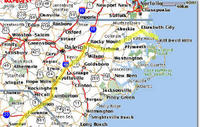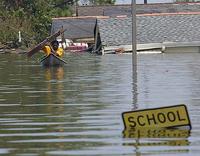-
WHOI expert: Haiti quake occurred in complex, active seismic region
Most of the time, the earth’s plates do not slide smoothly past one another; they stick in one spot for perhaps years or hundreds of years, until enough pressure builds along the fault and the landmasses suddenly jerk forward to relieve the pressure, releasing massive amounts of energy throughout the surrounding area; in Haiti, the tremor was centered just 10 miles southwest of the capital city, Port au Prince, and the quake was shallow — only about 10-15 kilometers below the land’s surface
-
-
Haiti earthquake poses prediction question
The Caribbean tectonic plate was moving eastward with respect to the North American plate at around 20mm per year, while Haiti was located close to the northern edge of the Caribbean plate; the 12 January 2010 Haiti earthquake occurred as a left-lateral strike slip faulting on the Enriquillo-Plantain Garden fault system (EPGZ); this fault system accommodates about 8 mm per year, and it is the likely source of a series of historical large earthquakes in the region such as in 1751, 1761, 1770, and 1860
-
-
The 106-foot San Clemente to be torn down, largest dam removal in California
California dam inspectors declared the San Clemente dam unsafe in 1991, at risk of collapse in a major earthquake; “In 1921, this dam was a marvel of engineering. It has fulfilled its purpose and its usefulness is behind us,” said Rob MacLean, president of the California American Water Co., which owns the dam
-
-
Haiti's earthquake was long anticipated
A group of scientists from the United States and Jamaica warned in 2008 that a fault zone on the south side of the island — the Enriquillo-Plaintain Garden fault zone — presented a danger; they predicted that a magnitude-7.2 earthquake would result if all of the strain along the fault “is released in a single event”
-
-
Flood-prone state road gets temporary fix

A section of Route 12, just north of the village of Rodanthe, North Carolina, increasingly has become flood-prone over the past decade due in part to rapid beach erosion in the area; wind-driven waves from a slow-moving mid-November storm buckled and undermined approximately 800 ft of pavement, flattened 900 ft of 15-ft to 20-ft-high sand dunes, and damaged hundreds of sandbags placed by NCDOT following a 2007 storm event; the North Carolina Department of Transportation has decided to relocate 1,800-ft-long stretch of the highway
-
-
Katrina Effect helped bolster flood defenses

Californians responded to Hurricane Katrina by approving, on 7 November 2006, a $4.1 billion bond measure for flood control; Proposition 1E was the largest single investment Californians had ever approved for upgrading the state’s flood defenses, and it was remarkable for several reasons
-
-
Scientists seek homes in the Seattle area in which to install quake monitors
Scientists want to install seismic monitors in homes in the Seattle area to measure ground-shaking; with detailed information on the way the ground shakes in a particular spot, it may be possible to design buildings tailored to their exact locations; the instruments also will help construct “shake-maps” to pinpoint areas of heaviest damage after major earthquakes
-
-
Vertical evacuation:: Fleeing tsunamis by moving up, not out
Stanford researchers who have studied the city have concluded that fleeing residents of a city hit by a tsunami would have a better chance of surviving the tsunami if instead of all attempting an evacuation, some could run to the nearest tall building to ride out the wave; this “vertical evacuation” could save thousands of lives, but only if the city’s buildings are reinforced to withstand both earthquakes and tsunamis.
-
-
Corps speeds testing of tubes for blocking breaches in levees
Lightweight Universal Gasket, called a PLUG, is a fabric tube that can be floated into place and filled 80 percent with water using an attached pump; the tube is pulled into the breach in the levee by the current, blocking more water from going through the breach; the tube is dropped by helicopter near the breach.
-
-
Rise in sea levels forces drastic changes on Florida
If sea levels rise by only two feet, Florida stands to lose almost 10 percent of its land area and the homes of 1.5 million people; the zone which is vulnerable to 27-inch rise in sea level includes residential real estate worth $130 billion, half of Florida’s beaches, two nuclear reactors, three prisons, 37 nursing homes, and much more; the Florida government is considering changes to building codes and other precautionary measures.
-
-
Rise in sea levels threatens California ports, infrastructure
Scientists expect ocean levels to rise by at least 16 inches over the next 40 years, causing flooding and endangering facilities throughout the state of California; the California Climate Change Center has estimated that nearly half a million people, thousands of miles of roads and railways, and major ports, airports, power plants, and wastewater treatment plants are at risk; in the Los Angeles-Long Beach-Santa Ana region, sea level rise could expose $96.5 billion of infrastructure to damage.
-
-
Visualizing climate change in the Bay Area
Governor Arnold Schwarzenegger unveils the CalAdapt Web site — a Web site developed by the California Energy Commission in conjunction with Google and the Stockholm Environment Institute; the site contains a Google Earth tour, narrated by Governor Schwarzenegger, of projected impacts of climate change on California, including snow pack loss, increased risk of fire, and sea level rises; CalAdapt’s unveiling coincided with the release of the “California Climate Adaptation Strategy,” which outlines recommendations for coping with climate change in urban planning, agriculture, water conservation, and other sectors.
-
-
New Orleans $1-billion flood defense revised
To head off a possible $150-million to $300-million cost overrun on the $1-billion Gulf Intracoastal Waterway West Closure Complex in New Orleans, the U.S. Army Corps of Engineers has redesigned the waterway; trading off some “nice to haves” for necessities.
-
-
Space Time Insight releases upgrade to Crisis Composite for extreme weather
The new Crisis Composite software for electric utilities correlates the effects of ice storms, hurricanes, earthquakes, and man made events; the solution allows operators of critical infrastructure facilities access to rich geospatial analytics that enable fast, informed action
-
-
Aussie telco says it is ready for the next Black Saturday
The bushfires in Victoria, Australia on 7 February took 173 lives, ravaged thousands of hectares of land, and burned down hundreds of houses; providers Telstra and Optus were both hit hard by the fires too, with communications outages across fixed-line and mobile networks, Internet exchanges and power stations; Telstra says its systems are now more robust
-
More headlines
The long view
The Surprising Reasons Floods and Other Disasters Are Deadlier at Night
It’s not just that it’s dark and people are asleep. Urban sprawl, confirmation bias, and other factors can play a role.
Why Flash Flood Warnings Will Continue to Go Unheeded
Experts say local education and community support are key to conveying risk.
